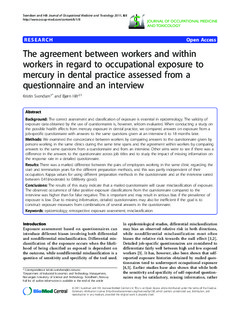| dc.contributor.author | Svendsen, Kristin V Hirsch | |
| dc.contributor.author | Hilt, Bjørn | |
| dc.date.accessioned | 2019-10-10T11:00:08Z | |
| dc.date.available | 2019-10-10T11:00:08Z | |
| dc.date.created | 2011-09-19T09:01:04Z | |
| dc.date.issued | 2011 | |
| dc.identifier.issn | 1745-6673 | |
| dc.identifier.uri | http://hdl.handle.net/11250/2621371 | |
| dc.description.abstract | Background
The correct assessment and classification of exposure is essential in epidemiology. The validity of exposure data obtained by the use of questionnaires is, however, seldom evaluated. When conducting a study on the possible health effects from mercury exposure in dental practice, we compared answers on exposure from a job-specific questionnaire with answers to the same questions given at an interview 6 to 18 months later.
Methods
We examined the concordance between workers by comparing answers to the questionnaire given by persons working in the same clinics during the same time spans and the agreement within workers by comparing answers to the same questions from a questionnaire and from an interview. Other aims were to see if there was a difference in the answers to the questionnaire across job titles and to study the impact of missing information on the response rate in a detailed questionnaire.
Results
There was a marked difference between the pairs of employees working in the same clinic regarding the start and termination years for the different preparation methods, and this was partly independent of their occupation. Kappa values for using different preparation methods in the questionnaire and at the interview varied between 0.41(moderate) to 0.88(very good).
Conclusions
The results of this study indicate that a mailed questionnaire will cause misclassification of exposure. The observed occurrence of false positive exposure classifications from the questionnaire compared to the interview was higher than for false negative. This is important and may result in serious bias if the prevalence of exposure is low. Due to missing information, detailed questionnaires may also be inefficient if the goal is to construct exposure measures from combinations of several answers in the questionnaire. | nb_NO |
| dc.language.iso | eng | nb_NO |
| dc.publisher | BMC (part of Springer Nature) | nb_NO |
| dc.rights | Navngivelse 4.0 Internasjonal | * |
| dc.rights.uri | http://creativecommons.org/licenses/by/4.0/deed.no | * |
| dc.title | The agreement between workers and within workers in regard to occupational exposure to mercury in dental practice assessed from a questionnaire and an interview | nb_NO |
| dc.type | Journal article | nb_NO |
| dc.type | Peer reviewed | nb_NO |
| dc.description.version | publishedVersion | nb_NO |
| dc.source.volume | 6 | nb_NO |
| dc.source.journal | Journal of Occupational Medicine and Toxicology | nb_NO |
| dc.identifier.doi | 10.1186/1745-6673-6-8 | |
| dc.identifier.cristin | 840224 | |
| dc.description.localcode | © 2011 Svendsen and Hilt; licensee BioMed Central Ltd. This is an Open Access article distributed under the terms of the Creative Commons Attribution License (http://creativecommons.org/licenses/by/2.0), which permits unrestricted use, distribution, and reproduction in any medium, provided the original work is properly cited. | nb_NO |
| cristin.unitcode | 194,60,25,0 | |
| cristin.unitcode | 194,65,20,0 | |
| cristin.unitcode | 1920,8,0,0 | |
| cristin.unitname | Institutt for industriell økonomi og teknologiledelse | |
| cristin.unitname | Institutt for samfunnsmedisin og sykepleie | |
| cristin.unitname | Klinikk for lunge og arbeidsmedisin | |
| cristin.ispublished | true | |
| cristin.fulltext | original | |
| cristin.qualitycode | 1 | |

